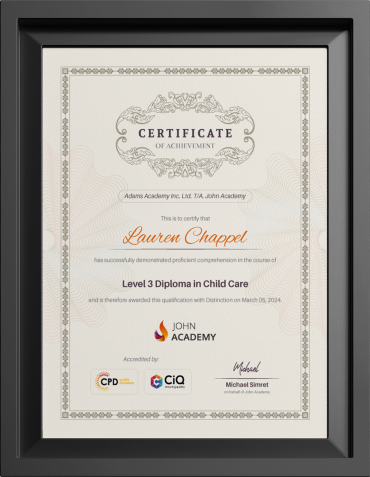
How to Say ‘I love you’ in Sign Language?
Sign language is the bridge between the hearing and the deaf community. This language enables the deaf community to communicate
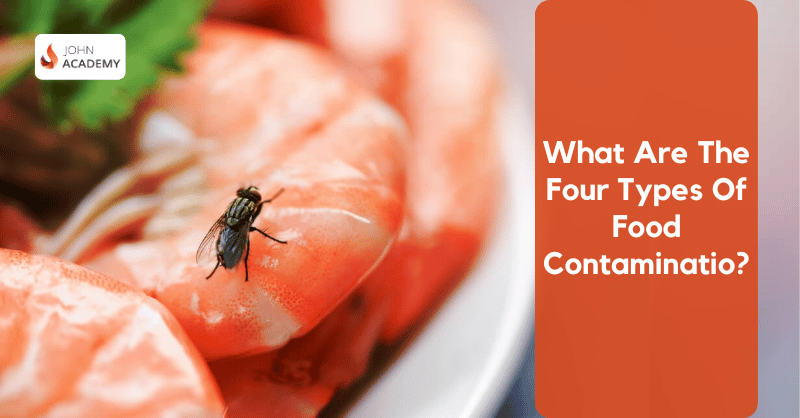
What are the four types of food contamination? And why do you need to know about it?
Imagine you bite into a juicy burger, and the next thing you know, you are in a hospital bed, regretting it. Food contamination is a serious global issue, putting our lives at risk. According to WHO, an estimated 600 million people worldwide – fall ill after eating contaminated food every year. That means almost 1 in 10 people are affected by food contamination.
It’s safe to say that food safety, nutrition, and food security are all connected.
However, sometimes, we don’t pay enough attention to the safety of our food. Most of us don’t know about the four types of contamination of food or how food contamination can have a long-term effect on our bodies.
We have prepared this blog to enlighten you on food contamination and safety. It will explain how food is contaminated, what its impact on our body is, and how to prevent it.
Food Contamination is when unwanted elements, for example, chemical or physical, enter your food and cause health issues. From preparing to packaging, food can get contaminated at any stage.
Contaminated food can pose serious threats to the consumer. And the most dangerous part is —you can not always identify contamination. For example, in chemical contamination, the taste and colour of the food stay the same. So, it’s important to know about food contamination.
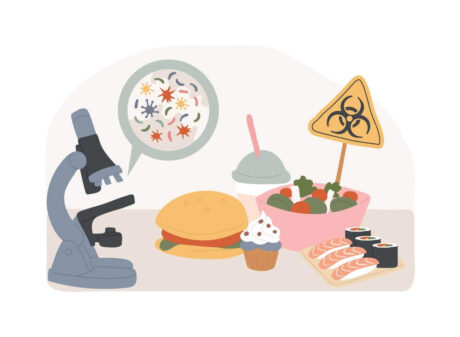
There are many ways food can be contaminated. However, according to the experts, there are four types of food contamination. They are mentioned below-
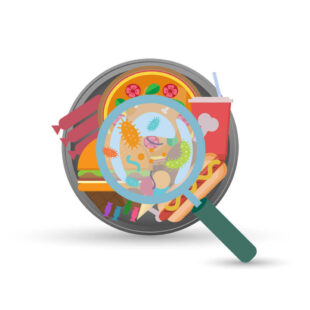
Chemical contamination occurs when harmful chemical substances get mixed with food. Pesticides from fruits and vegetables, cleaning agents, pest control chemicals, etc., can enter food. This can happen in any stage of food production and storage. These chemicals are responsible for causing serious health implications like food poisoning. Sometimes, consuming chemically contaminated food for a long time can cause chronic health conditions, such as cancer, developmental disorders, etc.
The prevention of chemical contamination requires following strict guidelines and protocols. Here are a few examples –
Microbiological contamination is when microorganisms, such as bacteria, mould, viruses, fungi, etc., enter and contaminate our food.
These contaminants can come from other food, or grow in the food over time. For example, if the food is kept at the temperature of 5 °C and 63 °C, the bacteria in the food can double in number. Hence, this is called the danger zone temperature. The common microorganisms found in the food are –
Food can get contaminated by microorganisms through various sources. Here are some sources of microbiological contamination.
The above-mentioned list is not conclusive. There are other sources of microbiological contamination as well.
To protect yourself from microbiological contamination, you must cook food at the right temperature to kill the germs. Maintaining personal hygiene and cleaning the cooking station, tools, and equipment is also crucial. In addition, you must keep the raw and cooked food separate. Lastly, you need to use separate utensils and tools to prepare meat and vegetables to avoid cross-contamination.
When foreign objects (not supposed to be consumed) contaminate the food, it is referred to as psychical contamination. The objects can range from small dust particles to larger objects that can cause serious hazards like choking, broken teeth, and cuts. Physical contaminants can also contain harmful bacteria.
There are numerous reasons behind physical contamination. For example, poor quality control measures, not maintaining hygiene, instrument malfunction, etc.
Every step counts, from small steps like covering the food to changing faulty equipment when it comes to preventing physical contamination.
Here is how you prevent physical contamination while preparing food at home.
But if you are preparing food in larger premises like a factory or restaurant along with the above steps, you should also consider the following precautions –
Allergic contamination is when allergic compounds enter the food that cause allergic reactions. Even a tiny amount of allergen in the food can cause serious allergic reactions. Allergic contamination can be very serious. From irritation to airway blockage, it can create a number of issues.
There are 14 prescribed allergens in food. Food businesses in the UK must be aware of them. These allergens need to be communicated to all customers. This way, someone with an allergy can make an informed choice of what they eat.
Allergens can contaminate food in different ways. For example, by using the same equipment for different food, storing allergic products with other foods, etc.
To avoid allergic contamination, it is vital to keep the allergic components away from other food. It is also important to clearly mention all the ingredients so that the consumers know what’s in the food. In addition, using separate utensils for allergic food also plays a significant role.
There are 14 food products that can cause allergic reactions in certain people. However, different people are allergic to different foods. Some are allergic to multiple foods.
Also there are many other allergens, but these are the most common ones. So, here are the names of the 14 major allergens –
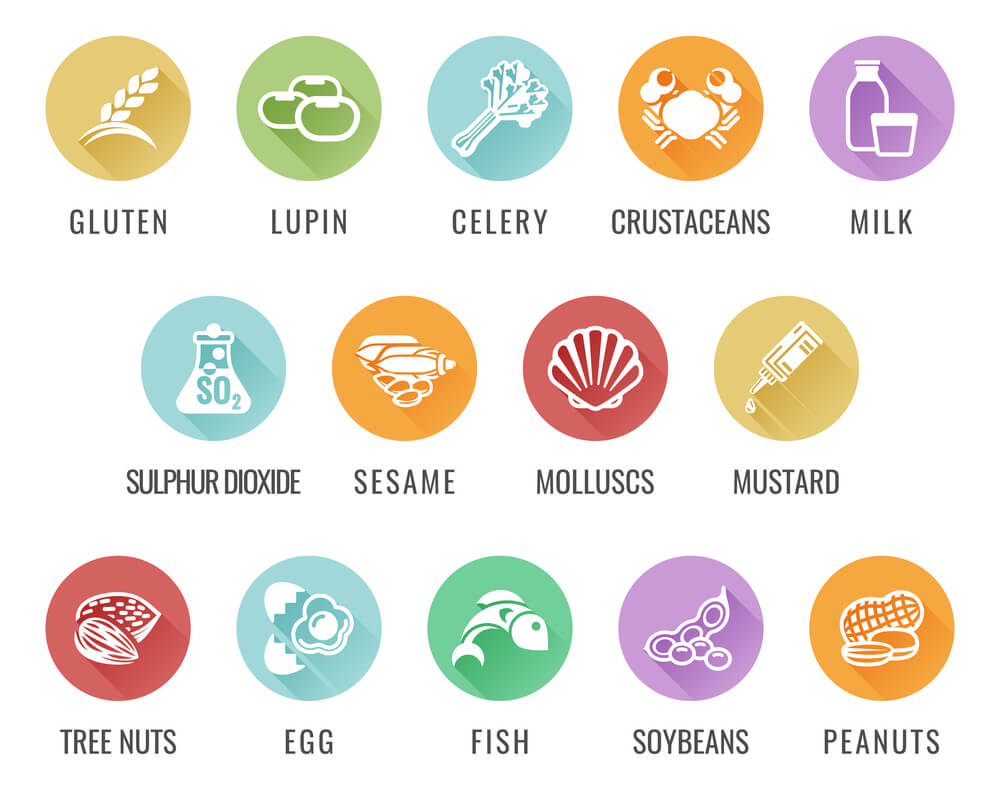
Food contamination can cause serious health implications. Contaminated food can cause mild to severe food poisoning. The symptoms of food poisoning are vomiting, nausea, diarrhoea, fever and stomachache. People can lose excessive amounts of water from their bodies due to vomiting and dehydration, which leads to dehydration and weakens the body once more.
Consuming food with chemical contamination for a long time can have a lethal impact on the body. They can cause chronic diseases like cancer, neurological syndromes, hepatic and renal syndromes. This contamination can lead you towards a dark future without leaving a trace.
On the other hand, allergic reactions can pose instant life-threatening risks. People get symptoms like itchiness, irritation or discomfort when the allergic reaction is mild. However, a serious level of allergy can lead to Anaphylaxis. It causes breathing difficulties for the affected individual. This happens due to airway constriction, drop in blood pressure, swelling of the throat, etc.
There are also economic effects of food poisoning along with the health implications. In the UK, around 2.4 million foodborne illnesses are reported. These cases together cost nearly £9 billion every year.

Consequences of Food Contamination for Businesses
Since 2015, companies have been obligated to learn about food allergies and inform consumers about them. Consumers have the right to make informed and safe choices about the food they buy.
When a company finds out food is contaminated, they have to recall the products. But recalling products is a costly procedure. It involves creating an investigation team, pulling the product from the market, building a crisis team, etc. The whole process takes up a great amount of time and money. Thus, the companies must ensure the food is safe before distribution.
In addition, serving contaminated food in a restaurant can put the business at risk. People will lose their trust and avoid coming to the restaurant. So, along with health and safety reasons, we should also maintain food safety for economic reasons.
Consuming contaminated food can cause food poisoning to any individual. However, there are certain groups of people who are more prone to food poisoning than others. These groups are –
Pregnant women are ten times more at risk of food poisoning than others. When women are expecting a child, they are in a vulnerable stage. So, germs and bacteria can attack them easily and pose serious threats.
Children under five years do not have strong immune systems. They’re less capable of battling germs and viruses than adults. As a result, the impact of diarrhoea and dehydration on their body is more severe.
As we grow old, our internal systems also grow weaker. Especially after the age of 65 years, our body loses most of its ability to identify the presence of harmful elements. And they are more prone to food poisoning.
People suffering from different illnesses like blood pressure issues, diabetes, kidney diseases or liver diseases have weak immunity. Their bodies do not have enough strength to fight germs and viruses.
Taking preventive measures is vital to ensuring food safety. Here is a list of strategies that are key to preventing food contamination.
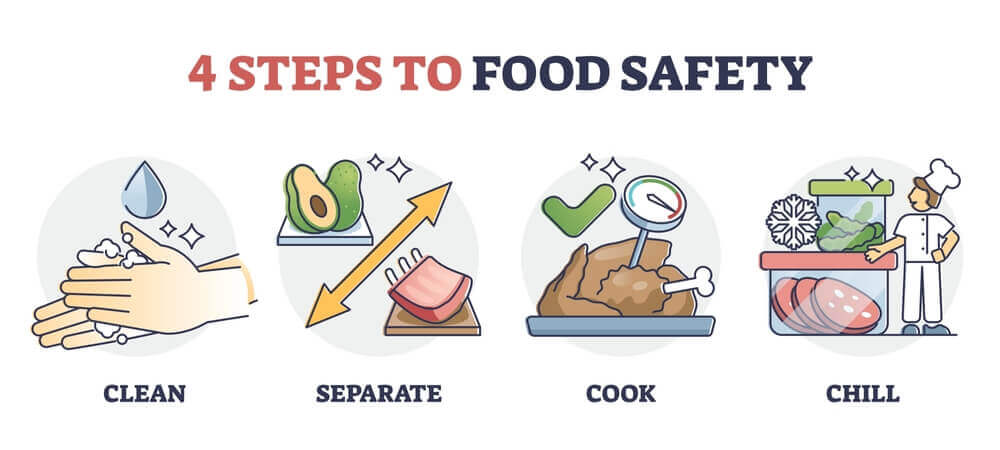
Maintaining personal hygiene and kitchen hygiene is the first rule of preparing safe food.
Prevent Cross-contamination
When contaminants from one food enter another, it is called cross-contamination. To prevent cross-contamination, you must separate the cooked and raw food.
In addition, you have to use different tools and utensils for meat and vegetables. Otherwise, the bacteria from the raw meat and fish can contaminate the vegetables. Also, you must store the raw meat and fish away from the vegetables in the refrigerator.
Food can easily get contaminated due to improper storage. Store the allergic food away from other food. In addition, keep the storage area clean and pest-free to avoid physical and microbiological contamination.
While storing in the fridge, keep the cooked food and leftovers in containers with tight lead. And keep them separate from the raw food. A more important aspect is storing the meat, fish, and seafood below 40 °F in the fridge.
Make sure you follow the recommended cooking temperature in the recipe. If the food is undercooked, the bacteria and other microorganisms may not get killed. For example, if there is Salmonella bacteria present in the chicken, and it’s not cooked properly, you can get food poisoning.
Along with cooking, reheating properly is also important. While reheating the food, you must keep it at 165 °F for at least 20 seconds. Doing this will kill any microorganisms that may have grown while it was stored.
When food is prepared in large amounts, like in hotels, restaurants and factories, different equipments are used. If they are not maintained well, mould, fungi and other microorganisms can grow on them and contaminate the food. Also, faulty and broken tools or equipment can cause physical contamination. Thus, it is mandatory to keep everything clean and well-maintained.
Food can get contaminated in the packaging stage as well. To prevent this, the packaging area and instruments should be clean. Also, the materials used for the packaging need to be checked. It should be ensured that they don’t possess any harmful chemicals or other risk factors. In addition, all the packages must contain the list of ingredients and expiry date. It helps consumers identify if the food is safe to eat.
Training is necessary for serving safe and healthy food to the customers. The staff working in different stages of food preparation should know about the four types of contamination. If they are well aware of the actions that can contaminate food, they will be better at preventing it. In addition, learning about the consequences of food contamination will motivate them to stay extra careful.
If you want to get a more detailed understanding of food safety and contamination control, the online Food Hygiene and Safety Level 3 course is perfect. This course will demonstrate all the essentials of food safety. By the end, you will be able to develop the skills to prevent contamination and serve quality food.
There must be no compromise when it comes to the safety of the food we consume. Whether you cook for your family or customers, you must maintain the safety protocol. Thus, learning about the four types of contamination of food is crucial. It will help you protect your food from different types of contaminants and prepare safe food for loved ones and your customers.
Food contamination is when different types of harmful foreign objects enter the food and cause foodborne illnesses. From mild discomfort or choking hazards to cancer, food contamination can cause many issues for our bodies.
Usually, food can be contaminated in four ways. They are chemical contaminants, microbiological contaminants, physical contaminants and allergic contaminants.
Due to food contamination, people can suffer from many foodborne illnesses. From food poisoning to anaphylaxis, food contamination can pose serious health risks.
Microbiological contamination is when harmful microorganisms enter the food and contaminate it. Usually, these microorganisms are germs, bacteria, viruses etc.

Sign language is the bridge between the hearing and the deaf community. This language enables the deaf community to communicate

Most people rely on their smartphones for all kinds of activities now. So, every business needs a dedicated mobile app.

We all know that philanthropy is very important. It is a vital expression of the nature of people, showing that

Picking the right delivery management software is a must-do because a shipping process that runs without fault results in happy

Remember when teaching meant classrooms and chalkboards? Today it’s often screens and software. But the goal remains the same: keep

In a competitive business landscape, it’s absolutely vital that companies keep a close eye on what their competitors are up
No more than 50 active courses at any one time. Membership renews after 12 months. Cancel anytime from your account. Certain courses are not included. Can't be used in conjunction with any other offer.
